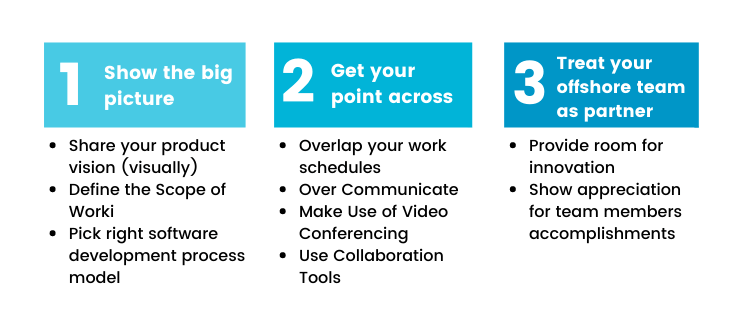Going remote requires robust online communication, effective file storage, and a viable collaboration plan.
An efficient offshore software development requires easy and quick online communication; an accessible, shared location for file storage; and a workable system for easy collaboration with remote teams.
In this guide, we'd be looking at the challenges that come with managing an offshore team. After which, we'd outline tips to help manage these challenges.
Challenges in managing offshore software development
There are some setbacks that come with working with an offshore team. Here are some of the most common challenges:
Keeping everyone in the loop can be harder than you think
Different Time Zones is the first and most consistent challenge. If work time doesn't overlap, communication can be difficult. This may cause remote developers to not see updates on time or be completely unaware of them until much later.
If there's a pressing issue for instance, and the in-house developers find a solution to it. Or make a little tweak. No-one may remember to inform the remote developers of this little change. They may end up developing something that isn't similar to what is being created in-house. This has nothing to do with bad communication or team dynamics. Time zone differences can easily cause one to forget to pass across information that later turns out to be important.
Poor planning impedes project delivery
Project success can be uncertain if planning is poor. If you don't properly communicate your plan or requirements with your outsourcing partner, it could lead to delays. The developers won't be able to deploy their full expertise until they fully understand your goals and requirements on a strategic level.
Here are three main factors that affect communication and planning:
- Client and partner speak different languages
- Poor use of communication channels
- Time zone difference
If there's a breach in communication, it could affect the progress of your project.
Cultural differences
This may initially not seem like much of a problem. Different cultures approach family, lifestyle and work processes differently. For instance, Swedish people tend to pay less attention to specifying the tasks in a project. If you are used to having your tasks outlined from the start, you may need to adjust when working with a Swedish team; so as to find a middle ground. Here's a much detailed breakdown of the cultural differences you may face:
Level of openness
A person's upbringing can affect their work behaviour. For example an Asian wouldn't want to question or contradict a superior. While this may be good in some instances, you may never find out if they had a suggestion that could have made the project more successful. It's important to encourage all members to be proactively involved in every aspect of the project while encouraging feedback.
Assertiveness (especially habit of making promises)
Some societies view assertiveness as socially unacceptable. This may cause an outsourcing partner to accept whatever suggestions you make just to "please the client". This suggestion may be wrong or there may be a better way around it. They may just choose to keep shut if they can't be subtle about it.
Tasks and goals orientation
The rapid development of technology has forced people to act quickly. Many people working in an IT organization are task & goal oriented and want to achieve them ASAP. But it depends on what kind of person you are and what culture you live in. Everyone has different priorities and a different style of action, not always oriented towards quick achievement of the goal.
Friendliness
Some cultures tend to value relationships more. They put effort into building long lasting relationships. This is common among Asians. They tend to spend several months on building a relationship before granting a project to a new vendor.
How to manage offshore software development

Managing an offshore team isn't as daunting as it may seem. These challenges are not without solution, and that's what this guide is all about. Offshore development is a cost-effective solution with other attractive benefits. We will be going into great detail on how to deal with challenges while providing you with tips to help prevent them from even happening in the first place.
This is to ensure that you are well prepared before diving into offshore development. This way you'd be able to handle whatever obstacle that may come up along the way.
Show the big picture
Share your product vision (visually)
The business value of the end result also depends on how well you communicate the business objectives. Your focus is business benefits. The offshore team's focus is meeting its obligation. If your business objectives are understood as part of their obligation, then you will have a project environment that encourages innovation.
Best practices
- Clearly state success definition. Probably the most important aspect is both parties being aligned in what success looks like. If it’s at all unclear what you want to achieve at the end, rewrite it.
- Show top level user journey walkthrough. This urges the offshore team to adopt a more user-centric approach and better relate sprints/milestones deliverables to the big picture
Define the Scope of Work
Naturally, you should have a roadmap, or detailed outline with feature lists and deadlines before starting a development. This helps the team understand what your business goals and project requirements are. It helps them divide tasks in a more effective manner, while giving the development a more structured process.
Best practices
- Make milestones a priority. They should be strategically planned to keep project teams on the path to meet deadlines. These can be simultaneously designed with meetings and client check-ins so that no one is left in the dark about progress.
- Include as many visuals as possible. Wherever possible show what you’re talking about rather than try to explain it. Visualizations, pictures, and examples go a long way in explaining your goals and needs.
- Allocate time for reviews and changes. A SOW is a plan. But at their best, plans are just educated guesses. Make sure your project schedule and deliverable timeline has space in it for reviews, pivots, and unexpected changes in priorities.
Pick right software development process model
There are various software development life cycle models defined and designed which are followed during the software development process. These models are also referred to as Software Development Process Models. Each process model follows a Series of steps unique to its type to ensure success in the process of software development.
Get your point across
Overlap your work schedules
One major challenge is the difference in time zone. In some cases, the offshore team is either a couple hours in the future or a couple hours back. If it's not streamlined, it could turn out to be problematic. Here's the twist, the difference in Time zones can actually be beneficial to both teams. One team could handle certain tasks while the other gets a goodnight sleep. This way the 24 hour day is maximised by splitting workflow between time zones.
Best practices
- Agree on a specific routine. When you pick your offshore team to partner, take out time to understand their work schedule. This will help you both better plan a convenient time to communicate and make good use of the work time lapse.
- Be flexible when necessary. Communication may not always happen at agreed times. Make room for one team to leave notes for the other if and when some issue comes up. That way the workflow doesn't suffer delay
- Incentives. The right incentive to one or two members of your offshore team could encourage them to adjust their work schedule to fit yours. Only if they are willing to, don't pressure anyone. You should be considerate.
Over Communicate
Leaving the offshore team in the dark from time to time is almost inevitable. Casual office chat could lead to a minor change in the project, which may not be relayed immediately to the offshore team. Make it a point of duty to over communicate.
Best practices
- Make good use of daily meetings. Ensure you stay in touch with the offshore team. Daily scrum meetings is a good way to start
- One-on-ones. Don't just stop at daily scrum meetings. If needs be, talk one on one with team members. This ensures that they're getting their work done and you can assist if there's something you can help with.
- In-house communicator. Assign someone in-house to ensure that the offshore team gets all the info they could possibly need. This person's roles would be to keep an eye on any changes to the project and communicate to the offshore team.
Make Use of Video Conferencing
Building human relations is important to work successfully as a team. Daily scrum meetings by phone or slack communication are good. Video on the other hand adds a touch of human element which helps you get to know them better and build better relationships.
Best practices
- Emotions and needs. Over video, you can see how a team member feels about a particular subject and this gives you perspective to help further.
- Build rapport. This is crucial because it helps the team members relax. This allows them to feel free making suggestions. Don't frown at a good joke.
Use Collaboration Tools
It's critical that everyone is up-to-date with the project's development process. This is made possible with the use of collaboration tools and project management apps. This way you have an idea of how the offshore team is performing and how long they spend on each task.
Best practices
- Agree on specific tools to use. When you agree on a tool to use. Ensure everyone is conversant with how to make use of it. Whether it's your team migrating to their tool or their team migrating to yours. Make sure to double-check that everyone can navigate the chosen tool
- Use a simple structure. Don't over complicate things. Try as much as you can to keep it simple. Tasks, timelines, delegated team members. All of these should be easy to find and attend to.
- Don't let it replace daily meetings. It is important to give feedback through these collaboration tools. If done right, you may begin to feel like you don't need daily meetings. Don't fall into that trap. Don't replace daily meetings. Unless there is a consensus that the project doesn't need daily meetings. Then things can be readjusted accordingly
Treat your offshore team as a partner
Avoid micromanaging
No professional wants to be micromanaged. According to a survey 71% of the correspondents believe that micromanaging affects their performance negatively. With 60% considering a change of job because of micromanaging. Now there's a thin line between monitoring the progress of a project and micromanaging it. Here are best practices to keep you on the good side of the line.
Best practices
- Communicate clearly. Set out the goals of the project in detail. Break down each task and agree on who is going to be assigned which. Now take your hands off and let them work. If a deadline isn't met or a task isn't done as agreed, that is when you can step in.
- Partner with the best. Most people micromanage their projects because they're afraid of something going wrong. Choose the right partner, with qualified IT experts. That way you are sure that they can handle any task given to them.
- Stick to agreed meeting schedules. Unless you need to send across very important information, don't reach out to the offshore team. Stick to scheduled meeting times. That's why it's important to build a healthy relationship with them. That way you can rest assured that if they were experiencing hiccups, they'd let you know.
Provide room for innovation
Let the offshore team know you welcome their ideas for improvement. Otherwise, you may get only what you asked for in the specifications.
When the system is designed and developed, significant opportunities for improvement may emerge. If you don't include offshore team room in the planning process you may lose this opportunity.
Best practices
- Listen first. Most of these IT experts have experience working on similar projects. So if one comes to you, or brings up an idea. Hear them out. Give it critical thought. If it doesn't sit well with your company vision, then you can best explain why you wouldn't be taken that route. That way they understand better and would feel free to come to you again if they had other suggestions.
- Discuss innovative plans with them. Sometimes the innovative idea could come from an engineer in-house. Just don't call the offshore team and dish out orders. Discuss this idea with them, they may iterate on it. This makes them feel like they are part of something. Not just developers working on a project. Build a relationship with them.
Show appreciation for team members accomplishments
Working remotely has been a welcome idea for the most part. It allows room for flexibility. 64% of correspondents for the survey said they feel recognition and appreciation is more important to them than working remotely.
You should start making plans to adapt employee recognition. A happy employee would put in more effort into tasks assigned to them. And this is good for you.
Only 1 out every 5 employees say their organizations have rewarded or recognised them ever since the pandemic.
Here are best practices to ensure you practise remote employee recognition.
Best practices
- Provide frequent, just-in-time employee recognition. Make sending an email or calling to say “good job” the norm for your team. This sort of micro-recognition helps create a culture of support and shows your team you see how hard they’re working.
- Encourage them to give each other positive feedback to introduce peer recognition to your remote team. This could be as simple as an email thanking a co-worker or a shout-out in a virtual meeting.
- Share the praise you’ve received from stakeholders, users, and customers. When you receive praise for a project that was worked on by an offshore team, don't fail to send this praise across to them.
Software Team Augmentation with SoftKraft
With Team Augmentation, our team becomes an integral part of your team. We carefully select each team member based on the requirements and expertise you need. They immerse themselves in your project, maintaining your company culture and working in line with your strategic goals.
Engage quality tech professionals
We are driven by 15+ years of experience in IT staff augmentation and engineering software development solutions.
Fast process: CVs within 3 days
Time and cost savings - receive first CVs of our specialists and start interviewing candidates.
Risk-free 2 weeks trial
To get rid of any doubts, check the quality of your team with no obligation to pay with 2-weeks trial.
Conclusion
Managing an offshore development team is bounded with some challenges. Knowing what difficulties may come your way will help you solve problems quickly.
An efficient offshore software development requires easy and quick online communication; an accessible, shared location for file storage; and a workable system for easy collaboration with remote teams. You can find more in Software Development Scope of Work [Template, Tips & Tools].







